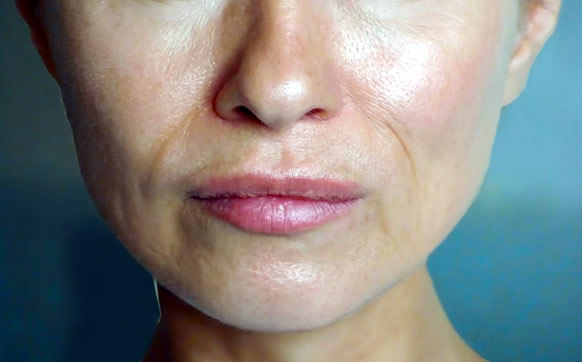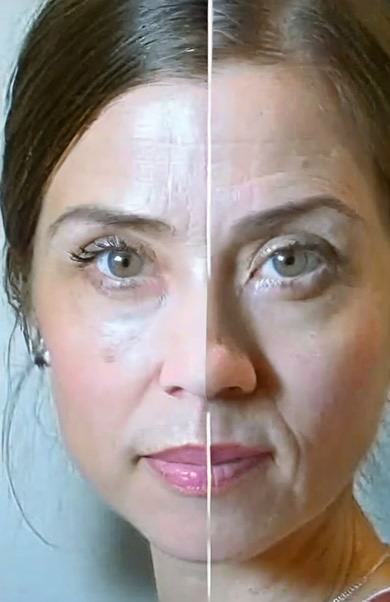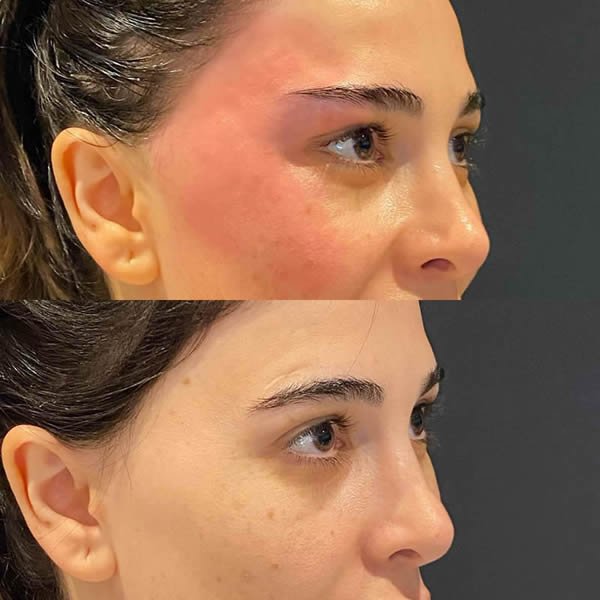
Face Sagging
Facial sagging is a natural condition that occurs with the aging process. With the loss of elasticity of the skin and muscle tissue on the face, sagging, loosening or wrinkles may occur on the face.
The most effective solution for sagging face is facelift surgery. In facelift surgery, the facial skin and muscles are stretched, excess fat and skin tissue are removed to achieve a tighter appearance. In addition, there are some non-surgical solutions for facial sagging.
Facelift Surgery
Facelift surgery (Rhytidectomy) is a surgical procedure that provides long-lasting results. The operation is performed under general anesthesia to tighten and reshape the tissues under the skin to correct sagging and wrinkles in the face and neck area and usually has a permanent effect. This operation usually takes 2-4 hours.
Although the recovery process after facelift surgery varies from individual to individual, it usually takes a few weeks. There may be swelling and bruising for the first few days, but these disappear over time. Full recovery may take several months.
Minimal scars may occur after surgery and these scars fade over time during the healing process. However, you should keep in mind that each individual’s healing process may differ.
Facelift surgery can generally give different results depending on age. However, it may be possible to achieve 7-10 years of rejuvenation with facelift surgery. Let us state again that the results of the surgery may vary from person to person.
Techniques of Face Lift Surgery
- Classic face lift: This technique is a traditional method to correct sagging in the face and neck area. Excess skin is removed and tissues are tightened.
- Endoscopic face lift: It aims to correct sagging in the face and neck area with the help of an endoscopic camera. This method requires smaller incisions.
- Deep face lift: Deep tissues are tightened and more pronounced results are achieved. Sagging and wrinkles in the deeper layers of the face are corrected.
- Mid-face lift: This technique aims to improve sagging under the eyes and in the cheek areas. It is used to remove sagging in the middle area of the face.
- Mini face lift: In this method, smaller incisions are used and only sagging in some areas is corrected. Milder results are achieved.
- Full face lift surgery: It is used to correct all sagging in the face and neck area. Excess skin is removed and the tissues of the entire face are tightened.
- Porcelain face lift: It is a method using porcelain implants to correct sagging and wrinkles on the face. It aims to provide an aesthetic appearance.
Preoperative Preparation
Some preparations should be made before surgery:
- You should have a thorough discussion with your doctor. You should get detailed information about the surgery and clearly express your expectations.
- You should tell your doctor about all your health conditions and any medications you are taking. Some medications may need to be stopped before surgery.
- If you smoke, it is recommended that you stop at least a few weeks before surgery. Smoking will negatively affect the healing process.
- Some laboratory tests and medical evaluations may be performed before surgery.
- You should fast the night before surgery and not even drink water at the specified time.
- A relative may need to help you with postoperative support treatments.
- Non-compliance: The results obtained after facelift may not meet your expectations. For this reason, it is recommended that you have a detailed consultation with your doctor before surgery.
How is Facelift Surgery Performed?
Facelift is a highly technical and complicated operation. Because the facial anatomy under the skin has a very complex structure.
After general anesthesia is applied to the patient, a surgical incision is made starting from the scalp above the ear and around the ear to behind the ear and the facial skin is lifted. The soft tissue causing sagging is suspended with the help of special sutures and the subcutaneous tissue is supported. Excess skin is cut off in the required amount. If necessary; it can also be combined with eyelid aesthetics. Since the scar caused by the surgery will remain under the scalp, there is no scar that will disturb the patient.
The sutures placed during the operation are removed 2 days later and the stitches are removed 1 week after the operation. There may be numbness and edema in the facial area for a few weeks after the operation. These postoperative conditions, which are considered to be extremely normal, decrease and disappear spontaneously.
Postoperative Process
After facelift surgery, the recovery process that patients face consists of several important stages. First, the swelling that occurs within a few days after surgery usually begins to decrease within a week, but it may take several weeks to completely disappear.
Complete recovery from facelift surgery usually takes several weeks to several months, depending on the patient’s health condition and the extent of the surgery. Postoperative sutures are usually removed one week to ten days after surgery.
The corset or bandage applied to the patients’ faces is usually worn continuously for the first few days after surgery, and this period may vary according to the doctor’s recommendation.
Postoperative edema is managed with proper care and sometimes with special techniques or medications recommended by the doctor. The facial suture area should not be in contact with water for at least one week, but this period may vary according to the patient’s condition and the doctor’s recommendations.
Before and After Facelift Surgery

Things to Know About Facelift Surgery
- Smoking and alcohol consumption should be stopped 10 days before the day of surgery.
- The intake of blood thinners such as aspirin, herbal teas with blood thinning effect and vitamin E consumption should be stopped 10 days before the operation.
- The operation varies between 4-6 hours. This period may be longer if the operation is performed in combination with a different surgery.
- The face is wrapped with a bandage after the operation (except for the mouth and nose area).
- Applying ice compresses after the operation accelerates the healing process and minimizes edema formation.
- It will be comforting to continue the ice compress when you feel an increase in temperature on your face during the recovery period.
- In order to ensure that postoperative edema is removed more easily, it will be useful to keep the head area above the heart level while lying down. Lying face down is strictly forbidden.
- The patient can be discharged from the hospital on the day of surgery, the operation does not require overnight hospitalization.
- It is normal to see mild bruising and tingling in the operation area after the operation.
- Within 1 week, the patient can return to daily routine, provided that it is not too tiring and challenging.
- Although low-paced walks can be done during the recovery period, any activity that increases the heart rate above 100 beats per minute and raises blood pressure should be avoided.
- Active sports should be waited for at least 1 month and contact sports with the risk of getting hit in the face should be avoided.
- It is recommended not to have sexual intercourse for 2 weeks after the operation.
Non-Surgical Face Lift
Non-surgical facelifts are possible and are techniques performed using non-surgical procedures. The duration of permanence may vary from person to person and provides temporary results.

It may be suitable for individuals with mild sagging or wrinkles. However, since each individual’s situation is different, it is important to consult a specialist to assess your personal situation.
A non-surgical facelift aims to fill the loss of volume in the face, smooth wrinkles or increase skin firmness, usually using fillers. Injectable products such as Botox can reduce wrinkles by temporarily relaxing muscles. Energy-based devices can stimulate the tissues under the skin to tighten.
Non-Surgical Face Lift Techniques
- HIFU (High-Intensity Focused Ultrasound): It targets the deep layers of the skin using high-intensity focused ultrasound. This method rejuvenates the skin by tightening and lifting the skin.
- Endolift: Laser energy delivered beneath the skin’s surface stimulates collagen production by tightening the skin’s natural tissues to increase skin elasticity.
- Photona: Restructures and tightens the skin using laser technology. Helps improve skin tone and texture.
- Golden Needle: It is a treatment that applies radio frequency energy to the lower layers of the skin with the help of micro-needles. It is used for skin tightening and renewal.
- PRP (Platelet Rich Plasma): It is a method of injecting platelet-rich plasma obtained from the patient’s own blood into the skin. It promotes skin renewal and rejuvenation.
- Thread Face Lift (French and Thread): Facelift is performed with special threads placed under the skin. These threads support the skin, helping to prevent sagging and improve facial contours.
- Functional Co2: It is a treatment method that renews and tightens the skin using carbon dioxide laser. It helps to reduce fine lines and wrinkles on the skin.
- Youth Vaccine: An injectable mixture containing various vitamins, minerals and hyaluronic acid used to moisturize, brighten and reduce fine lines.
- Salmon DNA: A method of injecting a serum containing polynucleotides derived from salmon DNA into the skin. It provides skin renewal and rejuvenation.
- Ulthera: It targets and tightens the deeper layers of the skin using ultrasound energy. It is known as a non-invasive facelift method and creates an instant lifting effect on the skin.
Home Remedies for Facial Sagging
- Face Patches: These patches are designed to temporarily tighten and lift the skin. These patches are usually used before special events or photo shoots and provide a short-term aesthetic improvement. However, the long-term skin tightening effects of these patches are limited and regular use may damage the natural elasticity of the skin.
- Facial Yoga and Exercises: Facial yoga consists of exercises that work various facial muscles. These exercises aim to tone facial muscles, tighten skin and rejuvenate facial expression. Facial yoga can improve skin health by strengthening facial muscles and increasing blood circulation. Exercising the facial muscles regularly can help facial contours appear more defined and firmer over time. Regular facial exercises can improve skin tone and reduce the appearance of fine lines on the face.
Face Lift Cost in Turkey
Facelift Surgeries in Turkey vary between $4000 and $10.000 according to many different variables.
